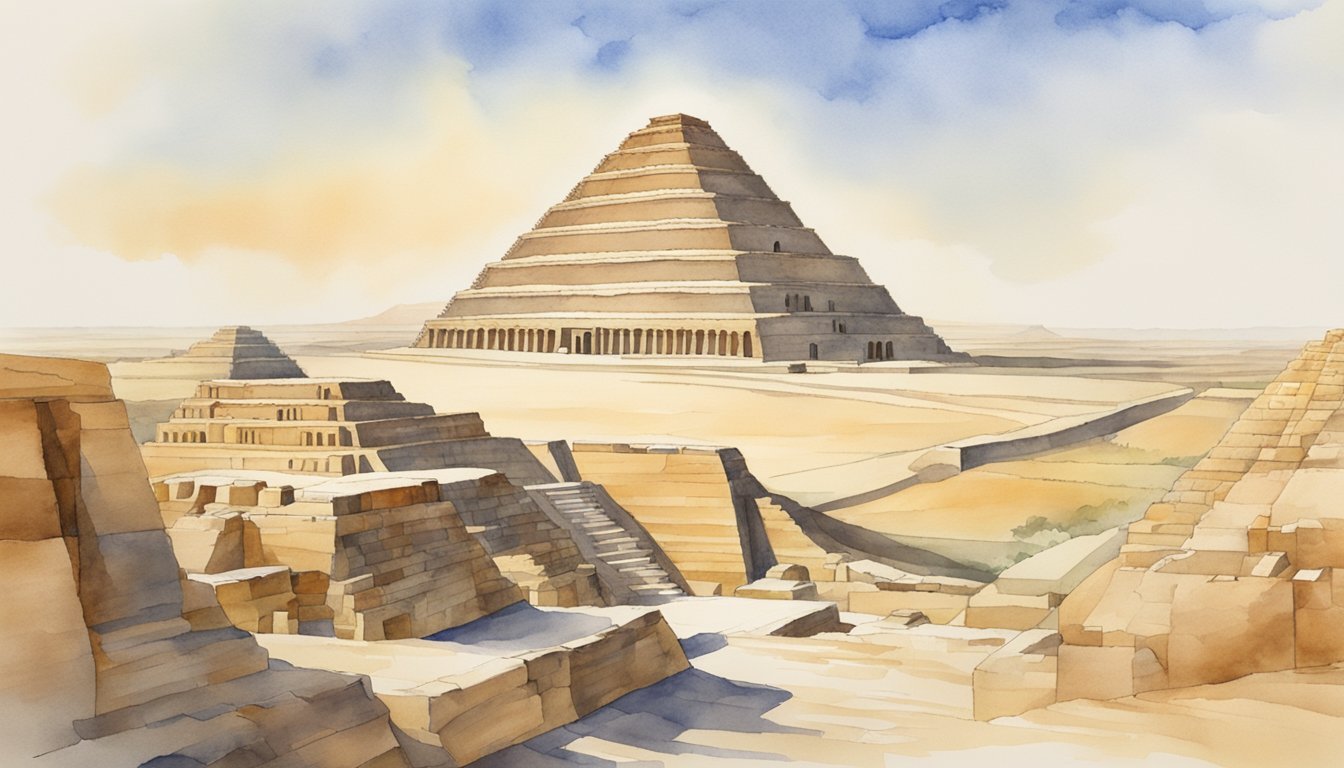Overview of Saqqara
Saqqara, located in Egypt, is an extensive archaeological site that was the cemetery for Memphis, the capital of Ancient Egypt. This site is part of the UNESCO World Heritage designation shared with Memphis and its surrounding pyramids.
The necropolis of Saqqara includes a vast array of tombs and pyramids. It dates back to the era of the Old Kingdom and continued to serve as a burial ground through the New Kingdom. The site spans over 4.3 miles in length, reflecting multiple dynasties and periods in history. Each part of Saqqara represents different eras and practices of ancient Egyptian burial culture, ranging from grandiose pyramids to more modest tombs.
A notable feature of Saqqara is the Step Pyramid of Djoser, which is the earliest colossal stone building in Egypt, marking an important evolution in pyramid construction. Saqqara’s significance lies in the wealth of information it provides on Ancient Egyptian civilization and architecture.
The region’s desert conditions have played a role in preserving many of the archaeological finds. Saqqara’s monuments exhibit the diverse funerary architecture that flourished in ancient times, including mastabas, temples, and other complex structures.
Despite degradation caused by weathering and human activity, ongoing restoration efforts aim to protect and study this treasure trove of history. Saqqara continues to yield new discoveries, offering insights into the beliefs, lifestyles, and governance of ancient Egypt.
Visit the Saqqarah necropolis to learn more about its historical significance and the ongoing research there.
Key Monuments and Discoveries

Saqqara stands as an illustrious testament to Egypt’s ancient civilization, showcasing monumental architectures and varied sepulchres that have continually provided insights into the practices and beliefs of the past.
Step Pyramid of Djoser
The Step Pyramid of Djoser, designed by architect Imhotep, is a terraced structure that revolutionized ancient Egyptian architecture. It’s an integral part of the pyramid complex which includes temples and courtyards reflecting the grandeur of the third dynasty.
Saqqara Tombs
The Saqqara Tombs include numerous mastaba tombs such as those of officials Aperel and Maia. These edifices provide a glimpse into the lives of nobles and the emphasis on afterlife provisions.
Pyramids Beyond Djoser
Saqqara is home to other significant pyramids, including the Pyramid of Userkaf and the Pyramid of Unas, which houses the earliest collection of Pyramid Texts.
Cultural and Religious Significance
This necropolis was a reflection of the culture’s deep-seated beliefs in the afterlife, a preparation site ensuring a safe journey to the netherworld.
Archaeological Discoveries
Recent excavations have unearthed new tombs, statues, and coffins, and discoveries such as the Wahtye tomb continue to rewrite historical narratives.
Historical Context
Saqqara served as the burial site for the city of Memphis and spans across dynasties from the Second to the Ptolemaic Period.
Animal Cults and Burials
The site reveals the practice of animal cults through the mummified cats dedicated to the goddess Bastet and the Serapeum that housed the sacred Apis bull.
Connections to Other Sites
Saqqara’s monumental legacy is connected to sites like Giza and Abydos, forming a grand ancient Egyptian sepulchral landscape.
Preservation and Conservation Efforts
The site is recognized as a UNESCO World Heritage Site and ongoing efforts aim to protect and restore this extensive mortuary city.
Famous Personalities
Leaders like King Djoser and the genius architect Imhotep are central figures in Saqqara’s history. Imhotep’s contributions to architecture are commemorated in the Imhotep Museum.
Structural Innovations and Architecture
The development of stone architecture from simple pits to monumental complexes here reflects significant evolutions in innovation and design.
Funerary Practices and Rites
The complex includes cult ceremonies and elaborate tombs, underlining the importance of funerary rituals to secure a favorable transition to the afterlife.
Modern Exploration and Research
Ongoing research continues to shed light on the layered history of the site, with the French contributing heavily to the deciphering of tomb inscriptions.
Egyptian Dynastic Chronology
Saqqara’s significance spans from the early dynastic periods through to the Old Kingdom and beyond, encapsulating Egypt’s extensive dynastic timeline.

